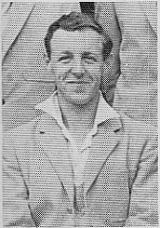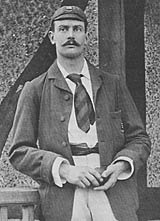The best who never were
John Arlott chooses a strong 'England XI' from those who were never thus honoured
|
|

|
There must always be debate about the considerable performers who were never chosen; and in that respect the opinions of their period are important. A team of English cricketers who never played for their country would give some actual Test XIs a hard game. Two men were, in their time, habitually described in the dressing-room as 'the best batsmen who never played for England'. They were John Langridge of Sussex and Maurice Hallam of Leicestershire; both opening batsmen. They would, too, give the team a couple of highly efficient slip fieldsmen, who in their careers took more catches than anyone else for their respective counties. If they are put into this 'team' it would be hard on Leslie Berry to be left out: he made more runs for Leicestershire (30,143 at 30.32) than anyone else; and on Emrys Davies of Glamorgan, who not only scored 26,566 at 27.84, but was both the first and the second man to perform the double for the county. Alan Jones, most cruelly of all, was 'capped' for England against the Rest of the World in 1970 in what was then labelled a Test but - sadly for him, though quite rightly - was subsequently declared 'unofficial'.
Some potential Test players have simply not continued with the game. One such was Edward Craig, the Cambridge Blue - another opening batsman - who turned out in a few games for Lancashire. Mike Brearley, an objective thinker on all subjects, not excepting cricket, once described Craig in their time at Cambridge as 'a better scholar and batsman than I was'. That made it compulsive to compare their records. So far as academic achievements were concerned, Craig had a first in both the parts of the Moral Sciences Tripos; Brearley a first in Classics and a 2(i) in Moral Sciences. At cricket, in 1961, Craig scored 0 and 105 in the University match, and over the University season, 1342 runs at 47.92; while Brearley, against Oxford, scored 27- and 23; and 1158 at 44.53. In 1962 Craig's figures were 35 and 3; 1113 at 37.10; Brearley's 113 and 31; 807 at 28.82: in 1963, Craig 43 and 17 and (busy with examinations) 424 at 30.28; Brearley 3 and 0 and (also busy with examinations but captain and playing six more innings) 790 at 30.38. In the following year Craig played no first-class cricket; Brearley made 119 in his only innings of the University match; scored 1313 for Cambridge at 57.08; was the second in the country to both 1000 and 2000 runs for the season, tenth in the firstclass averages, and chosen to go to South Africa with MCC.
Craig's cricketing possibilities remain intriguing; but not, apparently, to him. Dudley Owen-Thomas of Cambridge and Surrey promised more than he achieved: lack of a regular place seemed to upset a potentially fine player. The Cricket Writers Club elected him Best Young Cricketer of the Year in 1972; and their choices have usually prospered.
Richard Jefferson, too, spent a few seasons with Surrey; and he may well have been the greatest loss to English cricket in the post-war period. Coincidentally yet another Cambridge Blue, he had the advantage of considerable height and a proportionate build and strength. His bowling - especially of the off-break at unusually high speed - was his main asset. He achieved awkward lift off a length and, on a pitch which gave him any help, could be all but unplayable. As a batsman, he played straight and could drive powerfully. He generally held his catches and seemed to some sound judges likely to make an England all-rounder. He was ill in 1965 and played relatively little first-class cricket afterwards; but in club cricket he still gave evidence of immense potential.
Like the other two, he did not achieve enough to qualify for this strong XI. The first bowling place must go to Don Shepherd of Glamorgan, who took more wickets (2218) than anyone else who never played Test cricket. Monumentally accurate, he spun the ball hard and his extra yard of pace made him highly effective on slow turning wickets too sluggish to suit the usual type of finger spinner. He had a safe pair of hands; was a hectic hitter and an infallibly and philosophically cheerful cricketer. It is inexplicable that he was never chosen for England.
The same might be said of George Dennett, the Gloucestershire slow left-arm bowler. In his early days, though, he was contemporary with Wilfred Rhodes and Colin Blythe. Steady and unwavering in face of punishment on batsmen's pitches, he was an infallible destroyer when the ball turned. His 2147 wickets included some remarkable performances. In 1907, when Gloucestershire put out Northamptonshire for 12 runs - still the lowest total in firstclass cricket - Dennett took 8 for 9, including the hat-trick. In 1912, at Dover, when 30 wickets fell in a day, he put out the last six Kent batsmen in the course of 20 balls for no runs. Altogether in that match, he took 15 for 21 - all in the course of a single day. Third in the list of major wicket-takers who were never capped is Jack Newman of Hampshire with 2032. He was a dual-purpose bowler; fast-medium outswing with the new ball, then brisk offspin. In addition he scored 15,333 runs: performed the 'double' five times, and held 300 catches.
|
|

|
Returning to the standard of contemporary judgment, one credited Edgar Oldroyd of Yorkshire with being 'the best sticky-wicket batsman in the world'. A single innings of his has left in the memory an impression of quite elegant poise despite some awkward bowling; and, suddenly, when the bowler erred, an off-drive of superb style and timing. Men of much less distinction have been picked for England.
Another superlative was applied to Charles Kortright - 'the fastest bowler of all' - and it was related of him that once, in a club match at Wallingford, he bowled a ball which rose steeply and passed over the boundary without bouncing again - the only six byes in cricket history? William Gunn declared the ball with which Kortright bowled him in the Gentlemen-Players match at Lord's was a yard faster than any other of his experience. F. S. Jackson, writing in Wisden, emphasised that Kortright was 'not only a very fast bowler but a very good one'. In 1895 on the good Leyton wicket he took six Surrey wickets - including those of Hayward, Abel and Lohmann - for four runs.
Tom Wass virtually bowled Nottinghamshire to the Championship of 1907 with 163 wickets at 14.28; and took more (1679) wickets for them than any other bowler. C. B. Fry said of him that, on good wickets, he was simply fast and straight but that when there was any dampness in the pitch he bowled, in effect, fast leg-breaks, and was all but unplayable. Certainly in his old age the third and fourth fingers were wedged in the palm of his bowling hand from many years of being held aside from his 'legcutter'.
If Kortright and Wass are picked there is no room for Terry Spencer, a fine fast-medium bowler for Leicestershire and a splendid short leg; and Bill Ashdown was once described as 'the best allrounder who never played for England'.
A sequence of great English wicketkeepers prevented some extremely capable practitioners from winning Test places; notably Fred Huish, George Dawkes and Harold Stephenson. In this team, though, the place must surely go to Harry Martyn of Oxford University and Somerset. Wisden noted, when he first played for Oxford in 1899, 'it was obvious that a great wicketkeeper had been discovered'. In a relatively short career he never succeeded in displacing 'Dick' Lilley; but he kept outstandingly in the Gentlemen-Players matches of 1903, 1905 and 1906. In the last he created something of a sensation by standing up to the stumps to the fast bowling of Neville Knox and Walter Brearley. He was a good enough batsman to score 130 not out against the 1905 Australians.
Possibles among the batsmen are the unfailingly reliable Fred Gardner; the talented Martin Young; and two heavy scorers who had crucial weaknesses against fast bowling in Tommy Cook and 'Dot' Gibbons: while 'Peter' Perrin (another dubbed 'the best who never'), so gifted against high pace, was an extremely poor fieldsman. The side lacks a truly great batsman capable of dominating a match; so much rests upon the captain who must, surely, be Wilf Wooller. In 1948 his driving captaincy lifted Glamorgan from the ruck of the counties to the Championship; he twice performed the double and was a superb close fieldsman. He should have taken the 1950-51 team to Australia but had to refuse for family and business reasons.
The side, then, will be, in batting order: John Langridge, Maurice Hallam, Emrys Davies, Edgar Oldroyd, Jack Newman, Harry Martyn, Peter Sainsbury, Wilfred Wooller, Don Shepherd, Charles Kortright and Tom Wass.
The side bats down to No. 7. There are seven bowlers, Wass and Kortright, with Wooller in support, narrowly putting out Clem Gibson, Raymond Robertson-Glasgow and Emmott Robinson from the seam bowling. George Dennett is unlucky because two capable batsmen in Emrys Davies and Peter Sainsbury also bowl slow left-arm. It has at least six good catchers and a number of cricketers of competitive quality and good temperament: and it would be good to watch.
